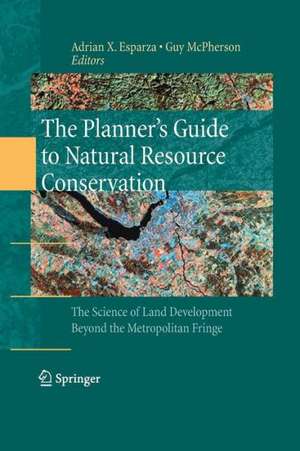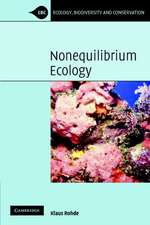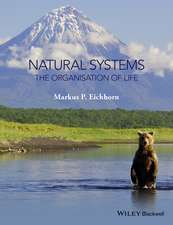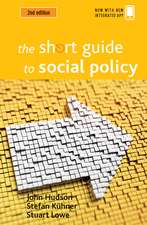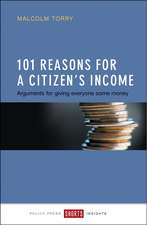The Planner’s Guide to Natural Resource Conservation:: The Science of Land Development Beyond the Metropolitan Fringe
Editat de Adrian X. Esparza, Guy McPhersonen Limba Engleză Paperback – 26 noi 2014
Our philosophy is reflected in the book’s two objectives. First, we seek to document the extent and impacts of exurban development across the country. At issue is demonstrating why planners and the public-at-large should be concerned about exurbanization. We will demonstrate that even though exurbanization favors amenity rich regions, it affects all areas of the country through the loss of agricultural and grazing lands, impacts to watersheds and land modification. A summary of environmental impacts is presented, including the loss of wildlands and agricultural productivity, land modification, soil erosion, impacts to terrestrial hydrologic systems, the loss of biodiversity, nonnative and endangered species and other topics.
Our second aim is to provide readers from diverse (nonscientific) backgrounds with a working knowledge of how and why exurbanization impacts environmental systems. This is accomplished by working closely to ensure contributors follow a specific outline for each chapter. First, contributors will spell out fundamental concepts, principles and processes that applyto their area of expertise (e.g., riparian areas). Contributors will move beyond a cursory understanding of ecological processes without overwhelming readers with the dense material found typically in specialized texts. For this reason, visuals and other support materials will be integral to each chapter. We have chosen contributors carefully based on their record as research scientists and acumen as educators. Second, once the mechanics have been laid out, authors will explain how and why land development in nearby areas influences ecosystems. Issues of interdependency, modification and adaptation, spatial scale and varying time horizons will be featured. Third, contributors will weigh in on the pros and cons of various land-development schemes. Fourth, authors will share their thinking on the merits of conservation devices such as wildlife corridors, open-space requirements and watershed management districts. Finally, each chapter will conclude by identifying pitfalls to avoid and highlighting "best practices" that will mitigate environmental problems or avoid them altogether. In sum, after completing each chapter, readers should have a firm grasp of relevant concepts and processes, an understanding of current research and know how to apply science to land-use decisions.
| Toate formatele și edițiile | Preț | Express |
|---|---|---|
| Paperback (1) | 639.73 lei 6-8 săpt. | |
| Springer – 26 noi 2014 | 639.73 lei 6-8 săpt. | |
| Hardback (1) | 645.96 lei 6-8 săpt. | |
| Springer – 6 iul 2009 | 645.96 lei 6-8 săpt. |
Preț: 639.73 lei
Preț vechi: 752.63 lei
-15% Nou
Puncte Express: 960
Preț estimativ în valută:
122.42€ • 128.40$ • 101.91£
122.42€ • 128.40$ • 101.91£
Carte tipărită la comandă
Livrare economică 01-15 aprilie
Preluare comenzi: 021 569.72.76
Specificații
ISBN-13: 9781489984357
ISBN-10: 1489984356
Pagini: 280
Ilustrații: XXII, 258 p.
Dimensiuni: 155 x 235 x 15 mm
Greutate: 0.4 kg
Ediția:2009
Editura: Springer
Colecția Springer
Locul publicării:New York, NY, United States
ISBN-10: 1489984356
Pagini: 280
Ilustrații: XXII, 258 p.
Dimensiuni: 155 x 235 x 15 mm
Greutate: 0.4 kg
Ediția:2009
Editura: Springer
Colecția Springer
Locul publicării:New York, NY, United States
Public țintă
ResearchCuprins
SECTION 1: HISTORY AND FUNDAMENTAL ECOLOGICAL CONCEPTS.- Exurbanization and Aldo Leopold’s Human–Land Community.- Fundamental Concepts in Ecology.- Climate Change and Ecology in Rural Lands.- SECTION 2: EXURBAN LAND DEVELOPMENT, HABITAT AND WILDLIFE.- Biodiversity and Residential Development Beyond the Urban Fringe.- Wildlife Corridors and Developed Landscapes.- Exurban Land Development and Breeding Birds.- Integrating Wildlife Conservation into Land-Use Plans for Rapidly Growing Cities.- Into the Wild: Vegetation, Alien Plants, and Familiar Fire at the Exurban Frontier.- SECTION 3: WATER RESOURCES, WETLANDS AND STORM WATER MANAGEMENT.- Impacts of Exurban Development on Water Quality.- Preparing for Human Expansion into Exurban Riparian Areas.- Storm Water Management in Exurbia.- SECTION 4: SCIENCE-BASED PLANNING IN EXURBAN AREAS.- A Science-Based Approach to Regional Conservation Planning.- Mitigating Environmental Problems in Exurban Development: An Overview of Rural-Specific Planning Devices.
Recenzii
From the reviews:“Editors Esparza and McPherson (both, Univ. of Arizona) have divided this 13-chapter work into four parts. … Each part offers a useful starting point for those interested in the intersection of exurban planning and environmental problems. … Summing Up: Recommended. … Upper-division undergraduates through professionals/practitioners.” (B. D. Orr, Choice, Vol. 47 (5), January, 2010)
Notă biografică
Adrian X. Esparza is Associate Professor in the School of Natural Resources at the University of Arizona (Ph.D. 1987, University of Illinois-Urbana). He taught previously in the School of Planning, College of Architecture at the University of Arizona. His research focuses on exurban land development in the southwest United States and urbanization in the United States-Mexico border region. He has published dozens of articles in the fields of urban and regional planning and regional science.
Guy McPherson is a Professor in the School of Natural Resources at the University of Arizona (Ph.D. 1987, Texas Tech University). He also worked for the University of Georgia, Texas A & M University, University of California-Berkeley, and The Nature Conservancy. His research focuses on development and application of ecological knowledge. His scholarly efforts have produced dozens of journal articles and eight books.
Guy McPherson is a Professor in the School of Natural Resources at the University of Arizona (Ph.D. 1987, Texas Tech University). He also worked for the University of Georgia, Texas A & M University, University of California-Berkeley, and The Nature Conservancy. His research focuses on development and application of ecological knowledge. His scholarly efforts have produced dozens of journal articles and eight books.
Textul de pe ultima copertă
Much of the country’s recent population growth is situated beyond the metropolitan fringe, where development consumes millions of acres of privately owned land. Exurbanization has become the dominant pattern of land development in America and there is no indication it will slow in the future. This development depletes agricultural and wildlands, and causes numerous environmental impacts ranging from the loss of biodiversity and wildland habitats to soil erosion, an increase in nonnative species, and the heightened threat to endangered species. Written for regional planners, planning commissions, local elected officials, environmental groups, and the public-at-large, The Planner’s Guide to Natural Resource Conservation provides readers from diverse, nonscientific backgrounds with a working knowledge of how and why exurbanization impacts environmental systems. Contributors include experts in rangeland ecology, restoration ecology, zoology, urban and regional planning, and conservation biology, who highlight the best practices to mitigate environmental problems or to avoid them altogether. Each chapter will leave readers with a firm grasp of relevant concepts and processes, an understanding of current research, and the know-how to apply science to land-use decisions.
Adrian X. Esparza is Associate Professor in the School of Natural Resources at the University of Arizona (Ph.D. 1987, University of Illinois-Urbana). He taught previously in the School of Planning, College of Architecture at the University of Arizona. His research focuses on exurban land development in the southwest United States and urbanization in the United States-Mexico border region. He has published dozens of articles in the fields of urban and regional planning and regional science.
Guy McPherson is a Professor in the School of Natural Resources at the University of Arizona (Ph.D. 1987, Texas Tech University). He also worked for the University of Georgia, TexasA & M University, University of California-Berkeley, and The Nature Conservancy. His research focuses on development and application of ecological knowledge. His scholarly efforts have produced dozens of journal articles and eight books.
Adrian X. Esparza is Associate Professor in the School of Natural Resources at the University of Arizona (Ph.D. 1987, University of Illinois-Urbana). He taught previously in the School of Planning, College of Architecture at the University of Arizona. His research focuses on exurban land development in the southwest United States and urbanization in the United States-Mexico border region. He has published dozens of articles in the fields of urban and regional planning and regional science.
Guy McPherson is a Professor in the School of Natural Resources at the University of Arizona (Ph.D. 1987, Texas Tech University). He also worked for the University of Georgia, TexasA & M University, University of California-Berkeley, and The Nature Conservancy. His research focuses on development and application of ecological knowledge. His scholarly efforts have produced dozens of journal articles and eight books.
Caracteristici
First, we believe that environmental conservation is promoted best by opening the door to science, especially to those most directly involved with land development decisions: planners, city and county planning commissions and boards, local elected officials, land trusts, environmental groups and the public-at-large. We include the public in this group because they are directly affected by exurban land development and play a critical role in land-use decisions by voicing concerns at public hearings and meetings Second, we seek to broaden the involvement of environmental scientists in land-use planning. That is, environmental scientists can, and should, comment on land-use decisions at the outset instead of providing expert testimony later in the process, or evaluating the impacts of exurbanization after the fact. There is a growing movement among environmental scientists for more active participation in the land policy arena: the book provides such a venue Includes supplementary material: sn.pub/extras
